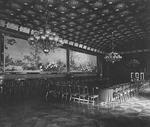Imperial Palace Complex
| Type | 175 Government Building | |
| Historical Name of Location | Tokyo, Japan | |
| Coordinates | 35.682500000, 139.752100000 |
Contributor: C. Peter Chen
ww2dbaseTokyo, Japan had been the home of the Japanese Imperial Family since Emperor Meiji relocated from Kyoto to Tokyo in 1868. Between 1888 and 1948, the entire complex was referred to as the Palace Castle (Kyujo). Most of the buildings in the complex seen during the WW2-era were built after Emperor Meiji's arrival, including the castle itself, which was built in 1888 (after the previous castle was destroyed by a fire on 5 May 1873). The main Palace Hall (Kyuden), ie. the very "Imperial Palace", was the largest structure on the grounds; this focal structure of the complex was where guests of the Emperor were received. In the late Taisho and early Showa periods, more concrete buildings were added to house the headquarters of the Imperial Household Ministry, the Privy Council, and others. Most of the buildings at the Palace Castle complex were destroyed during WW2, many of which during the raid of 25 May 1945 (24 May in most US records). By this time, Emperor Showa was spending significant parts of his day in a underground shelter, which was referred to as His Majesty's Library (Obunko Fuzokushitsu). After the war, in 1948, the western part of the complex was renamed Imperial Residence (Kokyo) and the eastern part was renamed East Garden (Higashi-Gyoen). In the 1960s, a new main Palace Hall was constructed. In 1968, the East Garden became a public park.
ww2dbaseSource: Wikipedia
Last Major Update: Jul 2017
Imperial Palace Complex Interactive Map
Photographs
 |  |
Imperial Palace Complex Timeline
| 2 Dec 1915 | Prince Takahito was born in the Imperial Palace at Tokyo, Japan. |
| 26 Apr 1945 | In Japan, 464 American B-29 bombers attacked the urban areas of Tokyo, Japan south of the Imperial Palace. |
| 20 Jul 1945 | HMS Indefatigable joined UK Task Force 37 and US Task Force 38.2 for an attack on the Japanese home islands. On the same day, an US Army B-29 bomber failed to attack the Imperial Palace in Tokyo with a large "Pumpkin" bomb. |
| 15 Aug 1945 | Emperor Showa addressed his nation via radio, announcing the end of the war. Meanwhile, the Japanese government informed the Allies its willingness to meet the unconditional surrender terms. In response, the US government ordered all hostilities to cease in Asia. A group of Japanese Army officers made a coup d'état attempt by attacking the Imperial Palace in Tokyo, Japan; it ended in failure. |
Please consider supporting us on Patreon. Even $1 per month will go a long way! Thank you. Please help us spread the word: Stay updated with WW2DB: |

Tokyo, Japan
Latitude-Longitude:
35.6825, 139.7521
- » 1,181 biographies
- » 337 events
- » 45,111 timeline entries
- » 1,247 ships
- » 350 aircraft models
- » 207 vehicle models
- » 376 weapon models
- » 123 historical documents
- » 261 facilities
- » 470 book reviews
- » 28,469 photos
- » 365 maps
James Forrestal, Secretary of the Navy, 23 Feb 1945